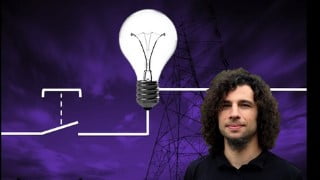Fundamentals of Electrical Controls
Learn the fundamentals of industrial control boards, motor control installation, fault finding, and maintenance in this comprehensive course. Perfect for electricians, pre-apprentices, and residential electricians looking to upskill. Gain practical knowledge and understand complex circuits with visual examples. Start your journey to becoming an expert in motor controls today.
What you’ll learn
- Learn the fundamental parts of industrial control boards and how they work.
- Learn how to install, wire and commission a basic motor control installation from scratch.
- Learn how to fault find, repair and maintain a basic motor control systems.
- Learn how electrical control components work and how to wire them up.
This course is an introduction to electrical controls with an emphasis on motor controls in the real world.
In this course, we focus on industrial and commercial installations, we will start with the absolute basics of electrical circuits. We look at the fundamentals of resistive circuits, and introduce Ohms Law, a mathematical formula that all electricians learn. The course looks at the different types of voltages and where they come from in the real world, focussing on transformer formations from the power supply authority, and AC and DC Voltages. As this is a course on the fundamentals of electrical controls, we will go through the basics of control circuits such as, normally open and normally closed, and look at how controls are made up of series and parallel circuits.
Taking a more practical approach to the subject, we dive inside control panels and look at each electrical component that we will be using later in the course, in our own motor control installation. We look inside the parts in detail and see how they work, discuss ratings, and learn how to size them up, with a particular focus on contactors and overloads. We also simplify an explanation of how an asynchronous motor works.
Before we get to wiring up our own control circuit, we look at the different types of control voltages in the real world and follow them from end device at the customers installation all the way back to the supply transformer at the power company, so we can see how a full installation might look, and get an insight into different systems that we might find in industry.
After learning the basics, we look at how we would install a motor control installation from scratch, including the motor itself. We get to see all the parts that we have learned about, working together in a mock real world installation, we learn how to size up the components and then go through the wiring of the circuit step by step. Part of installing a control board is commissioning it, so we go through the operation of the circuit after we have installed it to make sure it works.
Installations are often amended and modified in the real world, so we’ll look at a few ways in which we could modify our mock installation, change our wiring around and re-commission the installation.
At the end of the course, we’re going to challenge ourselves, and learn how to fault find a circuit as we would if we were called to a breakdown as an electrical controls technician. We’ll go through a few faults that we might come up against in the industry and look at how we might repair them. We also briefly touch on preventative maintenance techniques and discuss why they are important, for safety reasons and also financial reasons too.
Controls can be quite daunting and complicated, we will go through slowly and steadily, learning each part of the installation in detail before putting it all together, the course is weighted towards learning from practical examples, perfect for those of us that are visual learners. And, instead of enforcing hard and fast rules of how things must be done, We focus more on learning how to break down circuits and understand them for ourselves. I will show you wiring techniques used by Controls Electricians in the real world.
What is covered in the course:
- Learn the fundamentals: AC and DC voltages, 3 phase voltages, resistive circuits, ohms law, normally open and normally closed, series and parallel circuits, supply transformers (star & delta), faults to earth.
- Electrical components: Control panels, isolating switches, circuit breakers, fuses, contactors, overloads, asynchronous motors, push buttons, indicator lights, power supplies.
- Types of installations: Single phase, dual phase, power supply, mixed voltage control.
- Installation of a motor control circuit: Install electrical components, wiring of a mock installation, commission installation.
- Modifying an installation: Add and remove components, wire a hold in circuit, commission.
- Fault finding and maintenance: Fault find and repair, use a multimeter, preventative maintenance.
Are you ready to upskill?
Who this course is for:
- People interested in becoming an electrician.
- Pre-apprentices interested in learning motor controls.
- Apprentices that want to learn the basics of motor controls.
- Residential electricians that want to brush up on the motor control basics .
User Reviews
Be the first to review “Fundamentals of Electrical Controls”
You must be logged in to post a review.







There are no reviews yet.